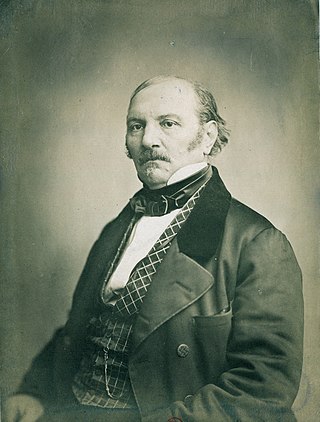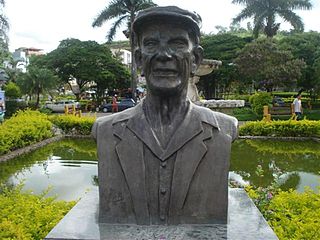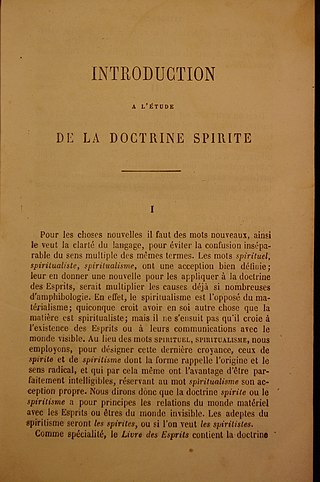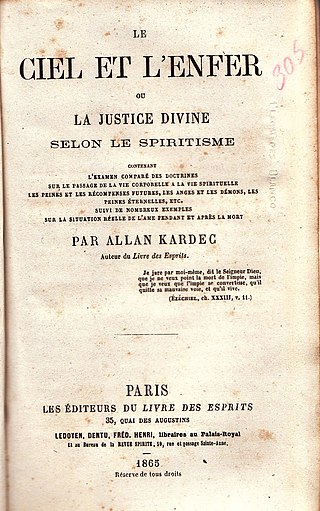Related Research Articles

Allan Kardec is the pen name of the French educator, translator, and author Hippolyte Léon Denizard Rivail. He is the author of the five books known as the Spiritist Codification, and the founder of Spiritism.

Spiritism or Kardecism is a reincarnationist and spiritualist doctrine established in France in the mid-19th century by writer and educator Hippolyte Léon Denizard Rivail. Kardec considered his doctrine to derive from a Christian perspective. He described a cycle by which a spirit supposedly returns to material existence after the death of the old body in which it dwelled, as well as the evolution it undergoes during this process. Kardecism emerged as a new religious movement in tandem with spiritualism, the notions and practices associated with spiritual communication disseminated throughout North America and Europe since the 1850s.

Umbanda is a religion that emerged in Rio de Janeiro, Brazil in the 1920s. Deriving largely from Spiritism, it also combines elements from Afro-Brazilian traditions like Candomblé as well as Roman Catholicism. There is no central authority in control of Umbanda, which is organized around autonomous places of worship termed centros or terreiros, the followers of which are called Umbandistas. The religion is broadly divided between White Umbanda, which is closer to Spiritism, and Africanized Umbanda, which is closer to Candomblé.

Chico Xavier or Francisco Cândido Xavier, born Francisco de Paula Cândido, was a popular Brazilian philanthropist and spiritist medium. During a period of 60 years he wrote over 490 books and several thousand letters claiming to use a process known as "psychography". Books based on old letters and manuscripts were published posthumously, bringing the total number of books to 496.
A spirit guide, in Spiritualism, is an entity that remains as a discarnate spirit to act as a guide or protector to a living incarnated individual.

The Gospel According to Spiritism, by Allan Kardec, is a book published in 1864 that relates the teachings of Jesus to Kardecist Spiritism, the moral and religious philosophy that Kardec had been publishing. It is intended to demonstrate that Spiritism clarifies and extends the most important teachings of Jesus. It is one of the five fundamental works of Kardecist Spiritism.
A spiritualist church is a church affiliated with the informal spiritualist movement which began in the United States in the 1840s. Spiritualist churches are now found around the world, but are most common in English-speaking countries, while in Latin America, Central America, Caribbean and Sub-Saharan Africa, where a form of spiritualism called spiritism is more popular, meetings are held in spiritist centres, most of which are non-profit organizations rather than ecclesiastical bodies.

Mediumship is the pseudoscientific practice of mediating communication between familiar spirits or spirits of the dead and living human beings. Practitioners are known as "mediums" or "spirit mediums". There are different types of mediumship or spirit channelling, including séance tables, trance, and ouija. The practice is associated with spiritualism and spiritism. A similar New Age practice is known as channeling.

The Spirits' Book is part of the Spiritist Codification, and is regarded as one of the five fundamental works on Spiritism. It was published by the French educator Hippolyte Léon Denizard Rivail, under the pen name of Allan Kardec on April 18, 1857. It was the first and remains the most important Spiritist book, because it addresses in first hand all questions developed subsequently by Allan Kardec.

The Book on Mediums or Mediums and Evokers' Handbook, is a book by Allan Kardec published in 1861, second of the five Fundamental Works of Spiritism — the philosophy Kardec had been publishing — being the tome in which the experimental and investigative features of the doctrine were presented, explained and taught.

The Genesis, Miracles and Premonition According to Spiritism was the last book published (1868) by Allan Kardec, just before his death. It tries to reconcile science and religion, and develops a series of important scientific and philosophical topics, relating them to Spiritism.

Heaven and Hell is an 1865 book by Allan Kardec, the fourth tome of the fundamental works of Spiritism. Its name was intentionally taken from a previous book by Emanuel Swedenborg, it was also subtitled "Divine Justice According to Spiritism".

What Is Spiritism? is a brief introduction to Spiritism written by Allan Kardec in 1859, which is about a quarter of the length of The Spirits Book. Modern editions are augmented by a brief biography of the author, written by Henri Sausse, in 1896 which is mostly focused on his role in the History of Spiritism.
Union Espiritista Cristiana de Filipinas, Incorporada is a religious Association with more than a thousand affiliated local and foreign based centers (churches), and considered as the biggest association of Christian spiritists in the Philippines. Foreign based centers are located in California, Texas, Canada, Hong Kong, Macau, Taiwan, Singapore, Greece, Dubai, Abu Dhabi, Hawaii, Germany, Italy, and Russia, where there are large Filipino communities. Union members are called "Christian Spiritists".
A Spiritist centre, also called Spiritist society or Spiritist house, is the basic unit of organisation of Spiritism, which is a distinct form of Spiritualism.

Espiritismo is a term used in Latin America and the Caribbean to refer to the popular belief that evolved and less evolved spirits can affect health, luck and other aspects of human life.
Spiritualism is a metaphysical belief that the world is made up of at least two fundamental substances, matter and spirit. This very broad metaphysical distinction is further developed into many and various forms by the inclusion of details about what spiritual entities exist such as a soul, the afterlife, spirits of the dead, deities and mediums; as well as details about the nature of the relationship between spirit and matter. It may also refer to the philosophy, doctrine, or religion pertaining to a spiritual aspect of existence.

This article is a chronological index of some of the main events in the prehistory and history of Spiritism, covering events from the 16th century - starting with the emergence of Spiritism in 1857 with the release of The Spirits' Book - until the end of the 20th century.

Following the emergence of modern Spiritualist events in Hydesville, New York, United States, via the mediumship of the Fox sisters (1848), the phenomena quickly spread to Europe where, in France, the so-called "turning tables" became a popular fad. In France, this type of phenomenon, in 1855, caught the attention of the educator Hippolyte Léon Denizard Rivail. As a result of his research, he published the first edition of The Spirits' Book, under the pseudonym "Allan Kardec". The foundation of the Spiritist doctrine is contained in this book and four others published later: The Mediums' Book, 1861; The Gospel According to Spiritism, 1864; Heaven and Hell, 1865; The Genesis According to Spiritism, 1868. These combined books are called the "Kardecist Pentateuch".

Denominated basic works of Spiritism, also referred to as Codificação Espírita, are five books published by the French educator Hippolyte Léon Denizard Rivail under the pseudonym Allan Kardec, between 1857 and 1868. The Basic Works are part of the Fundamental Works of Spiritist Doctrine, which comprise 11 publications by Allan Kardec.